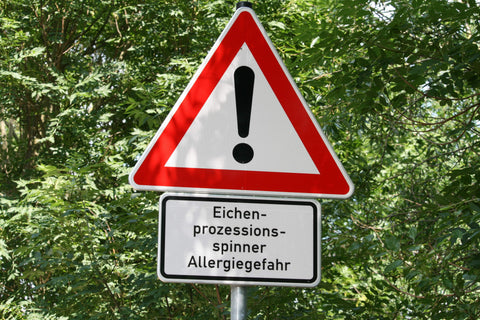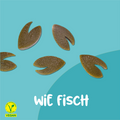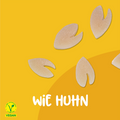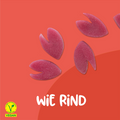What are oak processionary moths?
The oak processionary moth is a moth found throughout Central Europe. Its name comes from the unusual locomotion of its caterpillars: They often move in long lines, as if in procession, up the oak trunk or through the surrounding area.
While the adult butterfly is harmless and lives for only a few days, the real danger comes from the caterpillars. These appear in several larval stages starting in spring – and from the third stage onwards, they develop the notorious stinging hairs coated with the irritant thaumetopoein. These microscopically fine hairs actually serve as a defense against predators, but they also pose a health risk to other animals and humans.
The caterpillars form large webs on oak trunks that resemble cotton balls. Even after the caterpillars pupate, the nests and their toxic residues remain active long afterward.
Why are oak processionary moths dangerous for dogs?
Dogs explore their surroundings with their noses – often directly on the ground. This is precisely where the stinging hairs are located, which irritate the skin and mucous membranes upon contact. Particularly critical are the sensitive areas around the muzzle, eyes, and paws. Depending on the intensity of the contact, this can lead to rashes, allergic reactions, or even respiratory distress.
What's particularly insidious is that even if you don't see any caterpillars or the larvae have long since hatched, your dog can still come into contact with the hair. Anyone who lives in a known infestation area or walks their dog there should therefore be especially vigilant – even outside of the caterpillars' active season.
When are the risk months?
The danger to dogs from the oak processionary moth is especially high during the warmer months—typically between May and August. During this time, the caterpillars are in their active phase, developing their dangerous stinging hairs and leaving their nests in typical "processions" in search of food.
The greatest danger is usually from late May to mid-July, when the caterpillars reach the third larval stage. At this point, they bear millions of fine stinging hairs that can trigger severe reactions upon contact or inhalation. But be careful: Even after the main season, the shed hairs remain active in the environment. They cling to grass, soil, tree bark, or clothing and can be harmful for months.
Symptoms: How to recognize a reaction to the oak processionary moth
The symptoms of contact with the oak processionary moth can vary depending on the severity – the first signs often appear within a few minutes:
- Excessive salivation
- Sudden itching, especially on the face or paws
- Swelling of the lips, tongue or mouth
- Coughing, choking or difficulty breathing
- Restlessness, licking, scratching or trembling
- In severe cases: fever, vomiting or circulatory problems
First aid: What to do if contact is suspected
If you suspect that your dog has come into contact with the stinging hairs:
- Do not touch the affected areas with bare hands! The stinging hairs are also dangerous to humans.
- Contact your veterinarian immediately. Describe the symptoms and head to the practice.
- Keep dog calm – do not allow further rubbing or scratching to avoid worsening the irritation.
- Don't use water or home remedies! This can further activate or spread the hair.
Targeted treatment can be provided at the veterinary practice—usually with anti-inflammatory, decongestant, or anti-allergic medications. In more severe cases, hospitalization may be necessary.
Prevention: How to protect your dog from the oak processionary moth
Unfortunately, contact in affected areas cannot always be completely avoided – but you can significantly minimize the risk:
- Avoid known infestation areas: Forest edges, parks, or paths with oak trees should be avoided in summer. Check with your local authority for current warnings.
- Take the leash requirement seriously: It is a good idea to keep your dog on a short leash, especially near oak trees.
- Paw check after the walk: Examine your dog's paws, nose and fur after every walk – especially in high-risk areas.
- Learn how to identify caterpillar nests: The typical, cotton-ball-like webs on oak trunks are a clear warning sign. Keep your distance!










